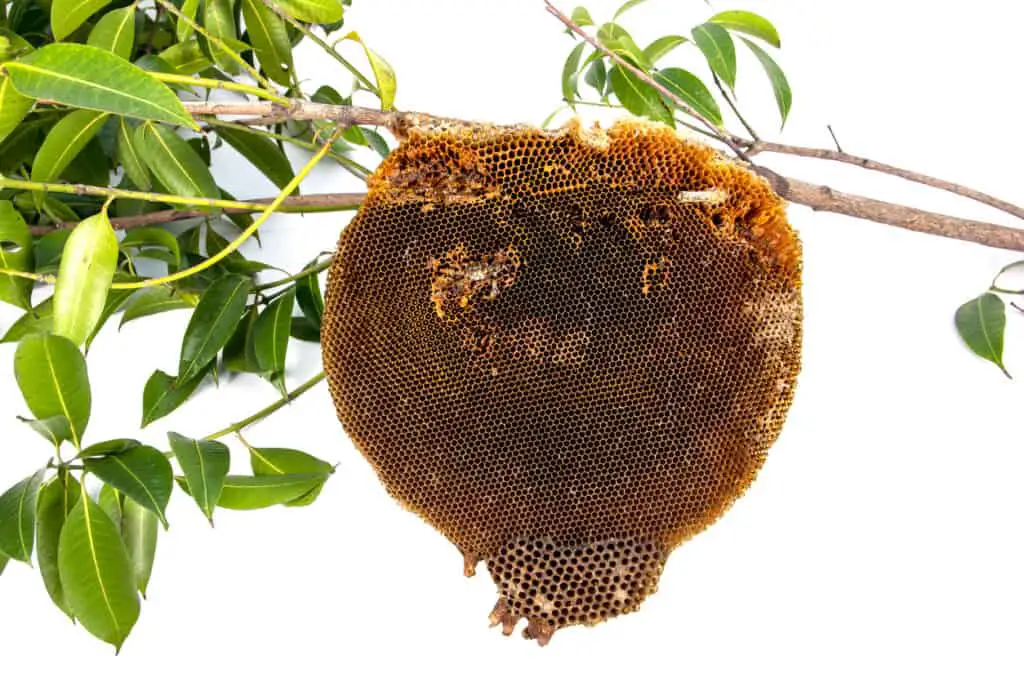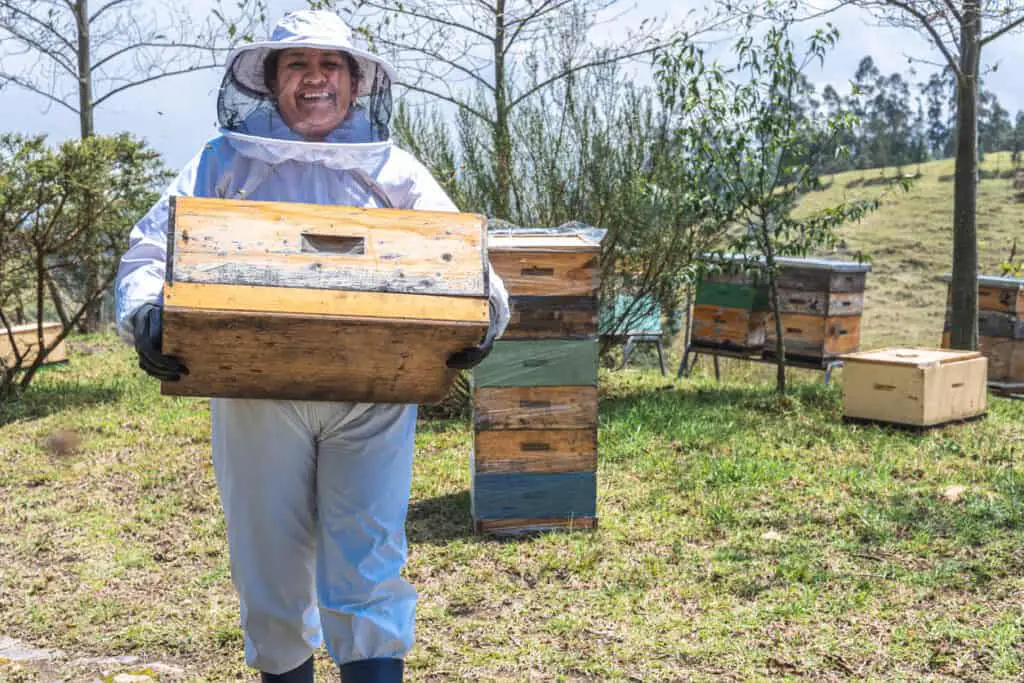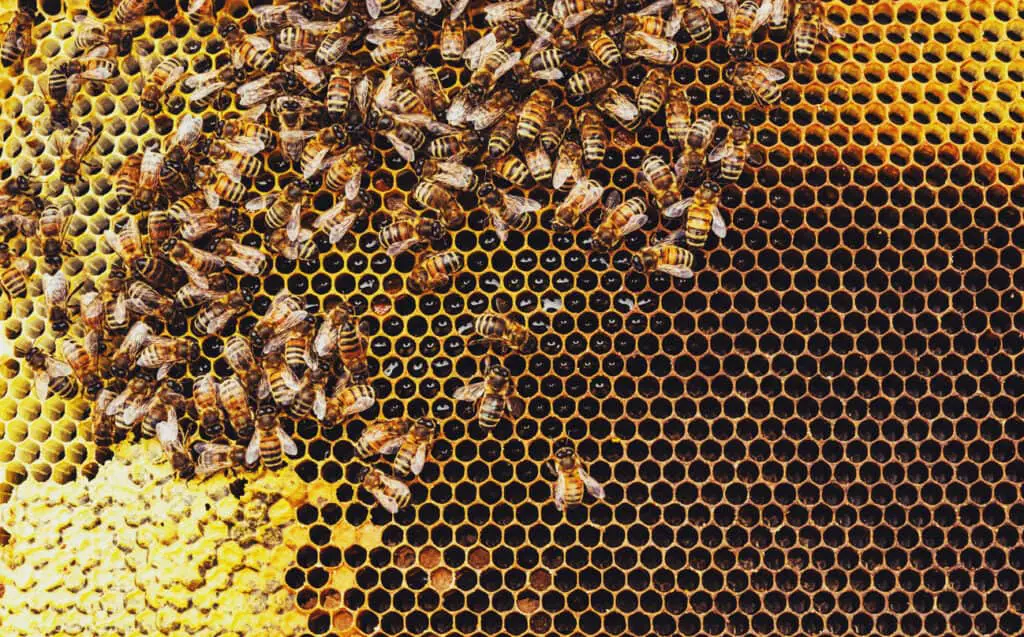Most people you come across love honey and enjoy it in various ways, but they might not be aware of where it comes from. Well, it must be harvested from manufactured boxes that play the role of hives, and the place these are found, we would likely refer to simply as a bee farm, but indeed a more “technical” term must exist. So what is a bee farm called?
A bee farm is referred to as an apiary, this being the name for the whole farm and all it includes. The person or beekeeper who tends to the bees, looks after them, and harvests their honey is an apiarist. And the practice of keeping and maintaining bees and hives is known as apiculture.

Okay, now you know the main terminology used when referring to bee farms, the act of bee farming, and the correct term for someone who tends bees. You are aware of what you came here to find out, but we have a lot more to discuss on the topic, from the history of beekeeping, to where you will likely find apiaries; thus, to learn this and more, be sure to read on.
What Is The Technical Term For A Bee Farm?

An apiary is any place where beehives are kept (by definition), but it is also used to refer to any site where you find bees swarming or molting. Beekeepers are rarely referred to as apiarists, but this is the correct term; therefore, we feel you ought to be aware of it. When talking about an apiarist, you will typically be talking about a beekeeper who focuses on a specific bee species.
An apiary (commonly referred to as a bee farm or bee yard) is where beehives and the colonies of bees that reside in them are housed. There are different types, sizes, and purposes of apiaries; some are for commercial use and are large scale, while others are smaller and kept by hobbyists or certain educational institutions for education on bee farming.
You can find apiaries in various places, and we shall go more in-depth into that later on, but for now, it is worth noting that they do not necessarily have to be kept in rural areas, but can also be found in urban spaces. If it is an urban apiary, it is far more common to find the hives placed on high ground, this usually reduces the amount of space required, but there are other reasons too.
Another reason they are placed in higher locations is to help direct the bees’ flight path in densely populated areas; this is why apiarists will often build fences to force the bees to fly higher to reach the hive and to travel to flowers. You will also often find that the hives used in urban areas will have openings at the top to direct the bees.
As mentioned, the structure of the hive can be made in such a way as to direct the bees’ flight path. However, there are other variations that all depend on the needs of the apiarist in question and the sort of operation they are running. In some cases, the structure may be roofed but wall-less, much like a gazebo, and it is merely used as a “cover” for the hive.
Where Did The Word Apiary Come From?

The base of the word derives from the Latin word “apis,” which means “bee,” and this, in turn, leads to the forerunner of “apiary,” which was “apiarium” and translated as “beehouse .”The first time that the word apiary was used dates back to 1654. The term apiarist, referring to a beekeeper, who usually focuses on one specific species of bees, only appeared in print in 1940.
How Old Is The Art Of Bee Keeping?
There are older examples we shall mention, but apiaries and the idea of domesticating bees has been found in Egyptian artwork, dating back roughly 4,500 years ago. The hives were constructions formed out of molded mud, and the honey was stored in jars; archaeologists have discovered some of these jars in the tombs of pharaohs, one of which was Tutankhamun.
In Egypt, from the Fifth Dynasty, roughly before 2422 BC, on the walls of Nyuserre, which was the sun temple, there are depictions of workers actively blowing smoke into beehives as they extracted the honeycombs.
Then many years later, in 650 BC, in the tomb of Pabasa, who was from the Twenty-sixth Dynasty, there are inscriptions on the production of honey and images of honey being poured into jars, as well as the depiction of hives of a cylindrical shape.
There certainly has been a long history of apiaries, and we know bees have been kept for their honey and the purpose of aiding in pollination for thousands of years, not only in Egypt but elsewhere. Some of the oldest depictions of people collecting honey from wild bees date back as far as 10,000 years ago. And 1,000 years later, there is evidence of beekeeping in North Africa.
So we are aware that there was a point where people started attempting to maintain colonies of wild bees in hives that had been artificially made from woven straw baskets, wooden crates, vessels made by potters, and even hollowed-out logs. There is evidence of this sort of practice in the Middle East, which seemed to start at roughly 7,000 BC.
However, it took us some time to understand bee colonies and the biology of bees, and we only seemed to acquire this knowledge in 18th century Europe. At this time in history, we also learned to construct the movable comb hive, allowing people to harvest the honey without causing long-lasting damage to the entire colony.
Therefore, owing to the definition of an apiary being the location where people keep beehives, the history of it can be traced back to the initial attempts of trying to domesticate bees and initiating the practice of beekeeping.
Where Are Apiaries Typically Located?
As in urban areas, apiaries are typically located on higher ground; in this case, it is usually done to avoid moisture buildup in the hive as this can negatively affect the honey. With this said, though, bees require water to drink, so the hives still need to be situated close enough to a water source; this could be natural but is often man-made.
On top of the need for water, there must be ample enough nectar supplies for the bees, and the area must acquire sufficient sunlight to ensure the growth of flowering plants. You will often find apiaries close to farms, orchards, and large flowering areas. These spaces provide the nectar for the bees to produce their honey, while the bees aid in pollination.
There is, therefore, a development of a positive feedback loop where the bees and their food source and the plant byproduct, which is the base for honey production, are in a give and take relationship, constantly reciprocating and sustaining and ensuring the continuation of one another.
Suppose you are located in the northern hemisphere. In that case, you may note that the locations of hives are predominantly east and south-facing, which is usually to capitalize on the full morning sun. However, there are areas where the climates are exceedingly hot, so shade is required for the hives.
This is because although the eggs need to be kept in warmer conditions if it is too hot, it could easily cause adverse effects. The shade provided could come from trees, or it may need to be artificially supplied if none are available.
An apiary and the apiarist overseeing it may have specific hive management objectives besides the production and collection of honey. Other byproducts can be sourced from it, along with the decision to engage in queen rearing and swapping out of the queens, especially when she begins to age; there is also the overseeing of the new queen’s mating with drones.
What Size Are Apiaries Usually?
The size of an apiary refers not only to the spatial dimension of the apiary. Instead, also (if not more so) the number of hives and the bees per hive. If you have sufficient space, there is theoretically no limit on how many hives or bee families you can keep in an apiary. We say “theoretically,” as there are determining factors present that must be considered before expanding.
The apiary’s purpose and function are among the first things that will affect its size. There is a range of reasons for an apiary to be started and maintained, from commercial to universities and research facilities—even local organizations. Therefore, the intention behind starting up the apiary will impact its size as there could be varying usage characteristics.
The higher the number of hives in an apiary will directly correlate to the honey yield; however, this is relative to the available resources. If there are sufficient resources, then apiaries tend to expand in time and as the apiarist gains more experience. This does not always happen, but the increase in the number of hives positively affects the honey quality.
However, with the above in mind, an apiarist must be aware of the availability of pollen and nectar sources within the area. Too many hives, with large numbers of bees, and the apiarist will be in a situation where their bees are hives competing for resources. This will directly impact how many hives can be kept in an apiary.
The competition for resources will ultimately negatively impact the apiary, and there will be a lesser yield of bee bread, flower pollen, and, most importantly, honey. It will also encourage the increase in robbing, where one hive will attempt to steal resources from another, and the bees will also become less healthy and resilient, thus making it a prime environment for spreading disease.
How Does One Start A Bee Farm?
Whether you are looking to start an apiary on a commercial, local wholesaler, or hobbyist level, there are vital things that you will need to learn before acquiring your hives and filling them with bees. You will need to consider an array of things, and unfortunately, we cannot cover everything in this segment.
We shall take a farm as an example as when you add any animal to a farm; you need to be prepared for them before they arrive on your land. This is the way to ensure that your journey into becoming an apiarist will be enjoyable and successful. So be sure to take heed of the recommendations below and do as much research on the topic before entering into this endeavor.
As we have discussed (under the location of apiaries), your bees will need access to clean drinking water. Still, the conditions must not be as such that there are high amounts of moisture in the area, as this will negatively impact honey production. Their hive(s) need to be sturdy and have sufficient amounts of sun (but in hot climates, you will need shade).
You want to also place your hive(s) in an area where they are protected from the elements, and note that in specific regions where it gets frigid in winter (and sometimes during other periods of the year), your bees will need feeding.
Be sure to research the surrounding area and ensure that there are sufficient resources for your bees to obtain pollen and nectar from. The radius of the site can be quite large, roughly 3 miles (5 kilometers). The bees will fly a great distance daily to various flowering plants to accumulate the required resources.
When acquiring your bees, one great option is a nuclear colony or nuc for short, which you can usually receive from an established local apiary. The benefits of purchasing a nuc are that the bees in the colony have already accepted the queen, the drones have mated with her, and the hive has already begun producing comb and honey.
All you need to do is get into your protective clothing, transfer the frames, which will likely come in a cardboard box, and place them in your hive. This brings us to the next point; you will need various tools and gear, such as protective clothing. If you are confused about the other items you need, you can always speak to an experienced apiarist, but you must have the clothing.
Some beekeepers do not wear protective clothing, but most do, even if they are experienced, and there is good reason for it. You will be handling a beehive, and there is no playing around. So be wise and invest in proper protective clothing; as a novice beekeeper, you may want to wear gloves and a hooded suit.
Experienced apiarists may elect not to wear the gloves as they feel it makes it difficult to manipulate the hive’s delicate aspects. However, you will rarely find a beekeeper that does not wear at least something to protect their neck and face. This is because breath attracts defensive bees, and being stung on the face leads to more significant pain and swelling.
Conclusion
We have seen that our love for honey and the desire to domesticate bees has been evident for thousands of years. The term for a bee farm, an apiary, dates back to 1654, and although a more “modern” word, by its definition, it can apply to practices done thousands of years ago.
Suppose you want to start beekeeping, then we hope this post has inspired you to seek more knowledge on the topic. If you were in search of merely the correct terminology, we hope you are leaving with a greater understanding of the art of beekeeping.
References
https://en.wikipedia.org/wiki/Apiary
https://en.wikipedia.org/wiki/Beekeeping
https://byjus.com/neet-questions/what-is-a-bee-farmer-called/
https://www.britannica.com/topic/beekeeping
https://backyardbeekeeping.iamcountryside.com/beekeeping-101/how-to-start-a-honey-bee-farm/
https://backyardbeekeeping.iamcountryside.com/beekeeping-101/top-10-reasons-for-starting-beekeeping/

